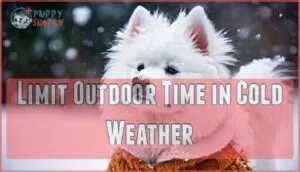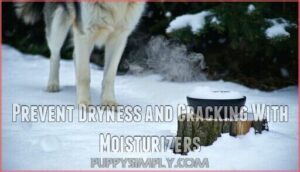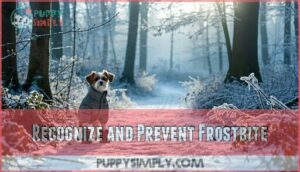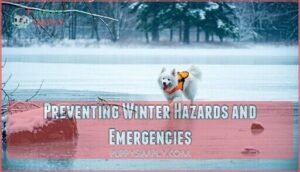This site is supported by our readers. We may earn a commission, at no cost to you, if you purchase through links.
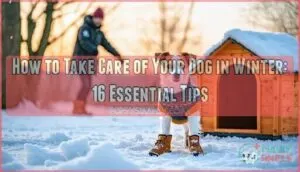
Set up a warm bed away from drafts, limit time outdoors during extreme cold, and adjust meal sizes based on how much your dog moves (winter usually means less running around). Look for signs of hypothermia like shivering that won’t stop or unusual tiredness. Keep water bowls filled—cold air dehydrates dogs faster than you’d think. Plan indoor games to keep them active and mentally sharp. The sixteen strategies below give you a complete approach to winter safety, covering frostbite prevention and what to do in emergencies.
Table Of Contents
- Key Takeaways
- How to Keep Your Dog Warm in Winter
- Protecting Your Dog’s Paws and Skin
- Adjusting Diet, Hydration, and Exercise
- Preventing Winter Hazards and Emergencies
- Frequently Asked Questions (FAQs)
- Can I use regular moisturizer on my dog’s paws during winter?
- Are there any specific hazards I should be aware of when walking my dog during winter?
- What are some signs that my dog may be experiencing hypothermia?
- How often should dogs visit the vet in winter?
- Can dogs get seasonal depression during cold months?
- What grooming changes help dogs in winter weather?
- Should I bathe my dog less in winter?
- Are certain dog breeds better suited for winter?
- Conclusion
Key Takeaways
- Dogs with short coats, small bodies, or senior status need extra winter protection through insulated clothing and limited outdoor exposure (10–15 minutes max in freezing temps), since they lose body heat significantly faster than larger, thick-coated breeds. – Paw care requires both prevention and maintenance—apply balm or booties before walks to shield against salt and ice, then clean and inspect paws afterward to catch cuts, irritation, or ice buildup before they become serious problems. – Winter hydration and nutrition need adjustment based on your dog’s lifestyle: outdoor dogs may need up to three times their normal calories to maintain body temperature, while less-active indoor dogs often need reduced portions to prevent weight gain. – Recognizing hypothermia warning signs (severe shivering, lethargy, pale gums, shallow breathing) and knowing emergency protocols—including vet contact info and first aid supplies—can be lifesaving when cold stress escalates quickly.
How to Keep Your Dog Warm in Winter
Winter weather demands extra attention to your dog’s comfort and safety. Understanding how to properly insulate, shelter, and monitor your pet during cold months prevents health issues and ensures their well-being throughout the season.
When winter hits, your dog needs a little extra TLC to stay comfortable and safe.
Making sure they have proper insulation, a cozy shelter, and regular check-ins during the colder months keeps them healthy and happy all season long.
Use Proper Winter Attire for Dogs
Just like you wouldn’t head into a snowstorm wearing flip-flops and a tank top, your dog needs the right gear to stay comfortable when temperatures drop. Winter coats and dog jackets with fleece linings protect short-haired breeds from biting winds, while thermal vests and snow suits offer extra warmth for smaller or elderly dogs.
Consider these winter dog care essentials:
- Dog sweaters keep your pup’s core temperature stable during short outdoor trips
- Waterproof dog coats shield against wet snow and slush that can chill quickly
- Insulated dog clothing with fleece linings provides essential belly protection for low-riding breeds
- Paw protection booties paired with proper winter attire create complete cold-weather coverage
Create a Cozy Sleeping Area
Your dog’s sleeping area should be just as warm and insulated as your own, since dogs lose body heat quickly when they’re resting on cold floors or in drafty spaces.
Place a cozy bedding setup on warm flooring or raise the dog bed off cold surfaces. Orthopedic beds work particularly well because they provide cushioning and insulation, and you can add dog blankets for extra warmth your pup can burrow into when temperatures drop.
Limit Outdoor Time in Cold Weather
Even when you’ve created the perfect warm sleeping spot indoors, cold weather still poses risks during outdoor bathroom breaks and walks. Watch for hypothermia signs like shivering or lethargy, and keep winter walks brief when temperatures drop.
Most dogs shouldn’t spend more than 10-15 minutes outside in freezing conditions. Cold weather safety means recognizing frostbite prevention starts with limiting exposure.
Consider Your Dog’s Age, Size, and Coat Type
Not all dogs face winter the same way. Age-Related Needs matter greatly—puppies under six months and senior dogs show up to 50% less cold tolerance than healthy adults, making them prone to hypothermia faster. Size Considerations are equally important; small breeds lose body heat twice as fast as larger dogs. Coat Insulation also plays a role, with shorthaired breeds and thin dog coats requiring extra protection.
Dogs don’t all handle winter the same way. Puppies younger than six months and older dogs can get cold much faster than healthy adults—their bodies just aren’t as good at holding onto heat, so they’re at a higher risk for things like hypothermia.
Size matters too; little dogs lose warmth twice as quickly as big dogs. And if your pup has a thin or short coat, they’ll need a little extra help staying cozy outside.
- Breed Predisposition: Arctic breeds like Huskies tolerate cold better than sighthounds like Greyhounds, which lack sufficient body fat.
- Health Status: Dogs recovering from illness or with chronic conditions face 2.5 times greater risk of cold injury.
- Coat type: Thick double-layered coats retain 80% more heat than short-haired breeds in winter weather.
Recognizing dog cold tolerance helps you tailor winter care—whether that means adding a jacket for your small senior dog or adjusting outdoor time for breeds less equipped to handle freezing temperatures. Some breeds, like Siberian Huskies, are naturally better suited for colder climates.
Protecting Your Dog’s Paws and Skin
Your dog’s paws and skin face real challenges when winter arrives—salt on sidewalks, icy surfaces, and dry air can lead to cracking, irritation, and even frostbite.
Taking a few simple steps before and after walks will keep your dog’s extremities healthy and comfortable all season long.
Use Booties or Paw Balm Before Walks
Think of winter sidewalks as a minefield for your dog’s paws—salt, ice, and freezing pavement can quickly turn a simple walk into a recipe for cracked, irritated skin.
Applying paw balm before walks creates a protective barrier against these elements, while dog booties offer even more coverage if your dog tolerates them. You’ll find balm easier to use, but some dogs need the extra defense booties provide against harsh conditions.
Clean and Inspect Paws After Walks
After every walk, make it a habit to wipe down your dog’s paws with a warm, damp cloth to remove salt, ice melt, and debris that can cause irritation or be harmful if licked off.
While drying, take a moment to inspect each paw for these signs:
- Cuts or wounds from sharp ice
- Redness indicating salt irritation relief needs
- Cracking between paw pads
- Ice balls stuck in fur
- Swelling or tenderness
This quick inspection frequency should happen after each outdoor excursion to catch problems early.
Prevent Dryness and Cracking With Moisturizers
Beyond just cleaning your dog’s paws after winter walks, you’ll want to apply a veterinary-approved moisturizer or paw balm to prevent the dryness and cracking that cold air and harsh de-icing salts can cause.
Look for pet-safe moisturizers with ingredients like shea butter or vitamin E, and gently massage them into your dog’s paw pads daily. This simple paw care routine provides essential paw protection and helps prevent skin dryness throughout winter.
Choose a paw-safe moisturizer with things like shea butter or vitamin E, then gently rub it into your dog’s paws each day.
A quick routine like this does wonders for keeping their paws comfortable and protected all winter long.
Recognize and Prevent Frostbite
Frostbite poses a serious winter hazard when temperatures drop below 32°F, particularly affecting your dog’s ears, paws, and tail. Small breeds, seniors, and short-haired dogs face three times the risk during cold exposure.
Watch for early frostbite signs like pale or bluish skin, coldness to the touch, and limping. Limit outdoor time to under 15 minutes in freezing weather, use insulated coats and booties for paw protection, and apply balm before walks.
If you suspect frostbite, move your dog indoors immediately and use warming techniques with lukewarm water—never rub affected areas, as this worsens tissue damage and requires emergency care. Prompt treatment is vital, as untreated frostbite can lead to cell death and potential amputation.
Adjusting Diet, Hydration, and Exercise
Winter changes your dog’s nutritional needs and activity levels, so you’ll need to adjust their routine accordingly.
Winter shifts how much your dog eats and how active they are, so their routine needs to change too.
Adjusting their food, making sure they have water, and getting creative with indoor exercise will keep your dog healthy through the cold months.
Modify Food Intake for Winter Needs
Your dog’s calorie needs shift during winter, though the adjustment depends on how much time they spend outdoors. Dogs living primarily outside may need up to two or three times their usual intake—around 1,400 to 2,700 calories for a 50-pound dog—to maintain body temperature.
Indoor dogs, however, often need fewer calories due to reduced activity, making weight gain a real risk if you don’t dial back portions accordingly.
Ensure Access to Fresh, Unfrozen Water
Keeping your dog’s water bowl from turning into an ice cube can be just as important as adjusting their meals. Dehydration happens fast in winter—heated indoor air dries them out, and frozen outdoor water access blocks hydration altogether.
Check your dog’s water bowl frequently throughout the day, especially if it’s outside. Heated water bowls prevent freezing and keep fresh water available.
Monitor your dog’s drinking habits closely, since maintaining dog hydration aids overall dog health during cold months.
Provide Indoor Exercise and Mental Stimulation
When icy sidewalks and shorter daylight hours keep outdoor adventures to a minimum, you’ll need creative ways to burn off your dog’s energy indoors.
Indoor games like hide-and-seek or tug-of-war work well for playtime. Puzzle toys challenge their minds, while training sessions reinforce good dog behavior. You can even set up simple agility courses using household items.
Don’t forget that social interaction matters too—invite another dog over for supervised indoor play.
Consult a Veterinarian About Supplements
Why should you consult your veterinarian before adding supplements to your dog’s winter routine? Over 66% of veterinarians emphasize this step to prevent adverse reactions and confirm dosage accuracy—critical since up to 17% of products diverge greatly from labeled concentrations. Professional guidance helps you choose quality supplements designed for your dog’s individual needs, whether that’s Omega3 for joint health and skin resilience or probiotics for immune aid.
It’s a good idea to check with your vet before adding any new supplements to your dog’s winter routine. Most vets strongly recommend this so you can avoid unwanted side effects and ensure you’re giving the right amount—especially since some products can be way off from what their labels claim.
Your vet’s advice helps you pick high-quality supplements that suit your dog’s unique needs, whether that’s supporting their joints and skin with Omega-3s or giving their immune system a boost with probiotics.
- Vitamin D adequacy, since dogs can’t synthesize it from sunlight
- Probiotics to strengthen immunity during cold months
- Glucosamine and chondroitin for senior dogs with stiff joints
- Proper dosing based on your dog’s size, age, and health status
Your veterinarian confirms supplement safety while addressing your dog’s specific winter wellness needs.
Preventing Winter Hazards and Emergencies
Winter brings hidden dangers that can quickly turn serious for your dog. From toxic antifreeze to hypothermia, knowing how to spot and prevent these hazards could save your pet’s life.
Winter can be full of surprises—but not all of them are good for your dog. Everything from antifreeze spills to freezing temperatures can pose a real threat, so it pays to know the warning signs and how to keep your pup safe.
Avoid Toxic Substances Like Antifreeze
Antifreeze tastes sweet to dogs, but just a lick or two can turn deadly within hours. Store antifreeze and other winter chemicals in locked cabinets your dog can’t reach.
Clean up spills immediately—even small puddles pose serious toxicity risks. Consider switching to pet-safe antifreeze alternatives, and keep your dog away from toxic winter plants like holly and mistletoe.
Supervise Around Heaters and Open Flames
While your dog might love cozying up near a crackling fire or radiator, those toasty spots can turn dangerous in the blink of an eye. Dogs can accidentally knock over space heaters or burn their paws on hot surfaces.
Keep a safe barrier between your pet and any heat source, and never leave them unattended near open flames, holiday lights, or electrical cords they might chew.
Watch for Signs of Hypothermia and Cold Stress
How do you spot trouble before it becomes critical? Shivering and lethargy are your first clues that your dog’s struggling with cold stress. Watch for pale skin, cold extremities like paws and ears, and breathing changes—these signal hypothermia is setting in.
How do you spot trouble before it becomes critical? Shivering and lethargy are your first clues that your dog’s struggling with cold stress. Watch for pale skin, cold extremities like paws and ears, and breathing changes—these signal hypothermia is setting in.
When body temperature drops below 99°F, you’re facing a real emergency. If your dog stops shivering, becomes confused, or collapses, you need veterinary intervention immediately.
Winter care isn’t optional when temperatures drop—it’s what keeps your dog safe from cold weather injuries that need emergency treatment.
Prepare for Emergencies and Veterinary Care
Even when you know what cold stress looks like, having a solid emergency plan can make all the difference if your dog’s condition takes a serious turn. Keep your veterinarian’s contact info handy alongside your nearest emergency clinic’s number. Build a basic first aid kit and maintain current identification tags on your dog. Schedule winter health checks to catch problems early, and know your insurance coverage for emergency veterinary visits.
- A list of emergency vet clinics with after-hours availability in your area
- Your dog’s medical records, including any cold-weather sensitivities or pre-existing conditions
- Antifreeze antidote information and poison control numbers saved in your phone
- Warm blankets and heating pads ready to stabilize your dog during transport
Frequently Asked Questions (FAQs)
Can I use regular moisturizer on my dog’s paws during winter?
Human moisturizers might seem harmless, but they can actually be toxic if your dog licks their paws.
Instead, you should use petsafe moisturizers or veterinarian-recommended paw balm specifically formulated for dogs. These safe moisturizers protect dog paws from dryness without ingredient safety concerns, and your vet can advise on proper application frequency for effective paw protection throughout winter.
Are there any specific hazards I should be aware of when walking my dog during winter?
Yes, winter walks present several hazards you should watch for. Antifreeze toxicity is extremely dangerous since dogs are attracted to its sweet taste. Ice melt and salt can burn paws and cause irritation.
Frozen ponds pose drowning risks, while reduced visibility and icy surfaces increase leash safety concerns. Always use paw protection and rinse thoroughly afterward.
What are some signs that my dog may be experiencing hypothermia?
When shivering intensifies or your dog seems unusually sluggish, hypothermia may be setting in. Watch for these warning signs:
- Severe, uncontrollable shaking that doesn’t stop when you bring your dog indoors
- Extreme lethargy signs like weakness, stumbling, or difficulty standing
- Pale or blue-tinged gum color indicating poor circulation
- Shallow, slow breathing rate paired with dropping body temperature
Contact your veterinarian immediately if you notice these dog cold weather hazards.
How often should dogs visit the vet in winter?
Generally, your dog should maintain their regular vaccination schedules and preventative screenings throughout winter. However, senior dogs or breeds with predispositions to cold-weather issues may benefit from additional check-ups.
Always consult your veterinarian about your dog’s specific winter health needs and emergency preparedness.
Can dogs get seasonal depression during cold months?
While we don’t have definitive proof, dogs can experience something like winter blues. Reduced daylight affects their mental wellbeing, causing behavioral changes—lower energy levels, increased sleep, or decreased interest in play. Monitor your dog for signs of Dog SAD and consider light therapy or indoor enrichment to promote canine comfort and overall dog health and wellness during seasonal changes.
- Watch for lethargy or withdrawal from normal activities
- Increase indoor playtime and mental stimulation
- Assure adequate exposure to natural daylight when possible
What grooming changes help dogs in winter weather?
Maintaining coat health through regular brushing becomes even more important during winter months. Brush your dog’s fur frequently to distribute natural oils that protect against cold and moisture.
You’ll want to trim excess paw fur carefully to prevent ice ball formation between toe pads, but avoid over-bathing since this strips protective oils.
Schedule strategic visits with your dog groomer for nail trimming and professional grooming advice specific to winter conditions.
Should I bathe my dog less in winter?
While you might think winter demands fewer baths, the truth is bathing frequency depends more on your dog’s lifestyle than the season.
Here’s what to prioritize for coat health:
- Use moisturizing shampoo types formulated for sensitive skin to prevent skin dryness
- Space baths 4-6 weeks apart unless your dog gets visibly dirty
- Consider grooming alternatives like dry shampoo or spot-cleaning between full baths
Regular dog grooming maintains your dog’s fur and aids winter care without overdoing it.
Are certain dog breeds better suited for winter?
Yes, breed cold tolerance varies greatly. Dogs with thick double coats—like Huskies or Malamutes—thrive in winter weather due to their regional breed origins in cold climates.
Meanwhile, short-haired breeds and smaller dogs lose heat faster, requiring extra protection regardless of their activity levels.
Conclusion
Winter care isn’t rocket science, but neglecting these basics could mean the difference between a healthy pup and costly vet visits.
Getting the basics right matters more than you might think—skip them, and you could end up with a sick dog and unexpected vet bills.
Keep monitoring their behavior, maintain their routine with indoor alternatives, and don’t hesitate to contact your veterinarian if something seems off.
- https://www.petmd.com/dog/care/how-cold-too-cold-dog
- https://www.aaha.org/resources/cold-safety-for-pets/
- https://www.amarillovet.com/services/blog/what-happens-when-your-pet-left-cold
- https://vetwoodstock.com/blog/winter-health-risks-for-pets-common-illnesses-and-how-to-prevent-them
- https://westandwillow.com/blogs/news/do-dogs-need-more-food-in-winter



